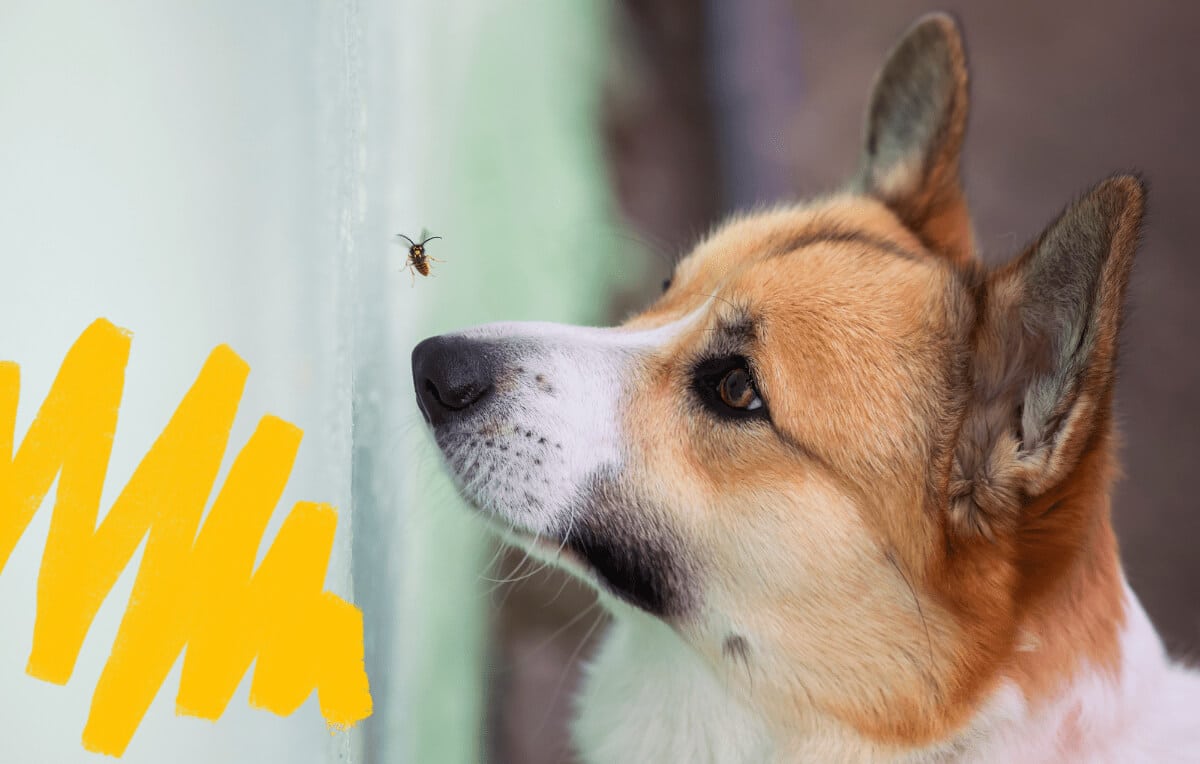Bee stings are NOT fun — for humans OR canines.
It may be exciting for dogs to chase after flying insects, but the thrill stops when they get stung by a bee. As an attentive pet parent, you might be extra concerned if your dog is the victim of a bee sting. After all, bee stings in dogs can be downright painful and scary. It can also lead to inflammation or, worse, anaphylactic reactions.
So what do you do once a buzzing bee proves it’s not playing around?
At DOGTV, we like to be transparent: we have affiliate relationships with other companies. We may receive a commission on qualifying purchases made via the links in this article at no extra cost to you.
What to do if your dog is stung by a bee
1. Stay calm.
After getting stung by a bee, your dog might be upset or in some pain. When this happens, tell your agitated self to buzz off. Chaos feeds chaos. If you are panicked, your dog will be too.
Remain calm while you assess the situation. More often than not, dogs recover from bee stings in less than a day. In some cases, bee sting in dogs leads to allergic or anaphylactic reactions.
That’s why it’s important not to let panicky feelings linger longer, so you can properly determine your next steps.
2. Ice the sting area.
To lessen pain levels while you continue to assess, put an ice pack on the sting immediately if possible.
If swelling occurs soon after a bee stings your dog, the cold relief also helps with the inflammation.
Ice pack not available? Run a towel under cold water and press it down on the sting site.
3. If possible, remove the stinger.
First things first: how does a bee sting in dogs work? It’s simple. A bee jabs a needle-like stinger into your dog’s skin. The stinger then injects the venom that causes pain and swelling.
If the stinger is still on the sting area, try to get rid of it to ensure it’s not continuously delivering venom and causing pain.
You can take the sting out of the situation with tweezers if necessary. Just be careful not to push it in further. If your dog is too upset and squirmy, wait until your dog settles.
4. Check for allergic reactions.
Some dogs may be allergic to bee stings. If you suspect that your dog might have been stung by a bee — perhaps you heard a sudden yelp while your dog is playing outdoors, or your dog is excessively licking a specific body spot — look for the following bee sting symptoms:
- Hives
- Swelling on the face, neck, or paws
- Inflammation near the sting area
Other symptoms might include changes in your dog’s behavior, such as aggression or agitation.
If your dog gets stung on the face and the swelling dramatically increases, observe if it’s causing issues with your dog’s breathing. For severe reactions such as wheezing, difficulty breathing, or vomiting, it’s best to contact your vet immediately, as your dog might be going through an anaphylactic shock.
5. Call your vet.
You may not immediately see allergic reactions once a bee stings your dog. Sometimes the symptoms take hours to materialize.
Once you note allergic reaction symptoms, it could be an emergency, so contacting your vet is urgent. You might also want to start driving your dog to the closest ER vet. The same is true if your dog happens to bump into a beehive. You’ll want to ensure multiple bee stings don’t cause major issues.
Even if hours have passed and there are no further symptoms, you should call your veterinarian to ensure you’ve done everything needed to treat the sting area properly. Your vet may prescribe over-the-counter antihistamines as needed.
You’ve got this! Your dog getting stung by a bee can be scary, but it’s nothing the most prepared pet parent around can’t handle. Use these steps as your guide, and you’ll know just what to do.
Key Takeaways:
- Bee stings in dogs can be downright painful. It can also lead to inflammation or, worse, anaphylactic reactions.
- The first thing to do is stay calm to best assess the situation.
- If possible, ice the sting area to reduce inflammation.
- If you can, remove the stinger with tweezers. Be careful not to push it in further, and only do this if your dog is calm enough and is allowing handling.
- Be on the lookout for swelling around the face, hives, or excess inflammation around the sting site. These symptoms might indicate an allergic reaction, and you should call your veterinarian.
- Call your vet, just to be safe. Even if there are no symptoms, calling your veterinarian for the next steps is never a bad idea!
- Bees and their stingers have NOTHING on you. You’ll take extra great care of your dog in this scenario. We’re confident in that.

